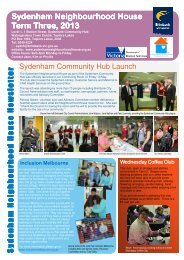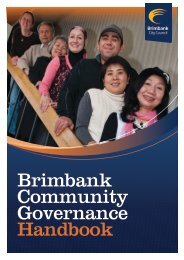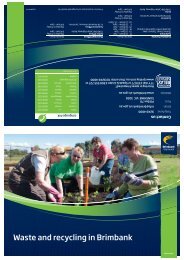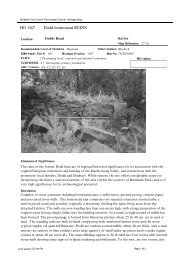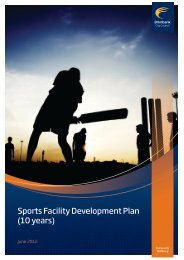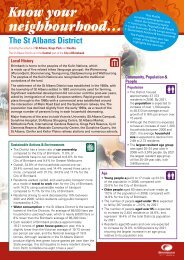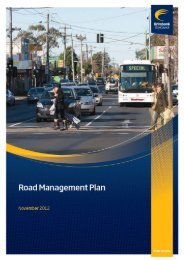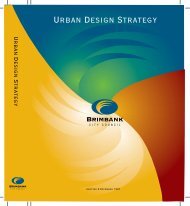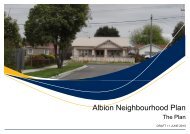The Diverse Communities of Brimbank Profile - Brimbank City Council
The Diverse Communities of Brimbank Profile - Brimbank City Council
The Diverse Communities of Brimbank Profile - Brimbank City Council
You also want an ePaper? Increase the reach of your titles
YUMPU automatically turns print PDFs into web optimized ePapers that Google loves.
Environment/Community infrastructure<br />
<strong>The</strong> Environment/Community<br />
infrastructure pr<strong>of</strong>ile theme contains<br />
three key data areas:<br />
• Environment/open spaces<br />
• Transport and Connectivity<br />
• Community Infrastructure<br />
An overview <strong>of</strong> the <strong>City</strong> <strong>of</strong> <strong>Brimbank</strong>s Environment<br />
and Infrastructure<br />
A sustainable community is based on the relationship between<br />
sociodemographic characteristics <strong>of</strong> the community and the level <strong>of</strong> access<br />
a community has to services and facilities such as housing, employment,<br />
education, health services, recreation facilities, accessible and safe public<br />
transport, and the opportunity to establish and maintain social networks through<br />
both planned activities and informal, spontaneous meetings. <strong>The</strong> communities<br />
<strong>of</strong> <strong>Brimbank</strong> enjoy a diverse range <strong>of</strong> environments – from semi rural agricultural<br />
properties abutting natural waterways and spaces, to urban areas with<br />
increasing housing densification. <strong>The</strong> diversity <strong>of</strong> areas across <strong>Brimbank</strong> attracts<br />
a diversity <strong>of</strong> households and individuals.<br />
<strong>Brimbank</strong> is a large area with pockets <strong>of</strong> the municipality without easy access<br />
to public transport options. <strong>Brimbank</strong> has a high car ownership rate relative to<br />
Greater Melbourne, with many residents utilizing a car to travel to work rather<br />
than other transportation methods. Reducing car dependency in the face <strong>of</strong><br />
peak oil and climate change, by supporting residents to live, work, play and shop<br />
locally is critical to support sustainable communities. Housing growth in newer<br />
and establishing suburbs is particularly at risk <strong>of</strong> car dependency as public<br />
transport infrastructure is limited.<br />
<strong>Brimbank</strong>’s residents are relatively efficient energy users, with many<br />
households producing a smaller ecological footprint than households across<br />
Victoria. Although, higher water consumption across the municipality indicates<br />
water conservation needs to be encouraged for <strong>Brimbank</strong> to come into line with<br />
sustainable consumption patterns.<br />
<strong>Communities</strong> across <strong>Brimbank</strong> have lower rates <strong>of</strong> civic participation and<br />
participation in arts and culture activities, and lower rates <strong>of</strong> participation<br />
in sporting and recreational opportunities than the State average. Issues <strong>of</strong><br />
connectivity across the municipality restricting easy access to destinations may<br />
be a contributing factor in lower rates <strong>of</strong> participation.<br />
Compared to Greater Melbourne house prices in <strong>Brimbank</strong> are relatively<br />
affordable, although significant increases in housing prices have been seen<br />
over the past 10 years and mortgage stress in <strong>Brimbank</strong> is particularly high.<br />
Despite having relatively high incomes, households have relatively high levels<br />
<strong>of</strong> mortgage. This is a concern, as it indicates that those on the higher incomes,<br />
who by definition are not susceptible to housing stress, are paying very high<br />
mortgages and may have low rates <strong>of</strong> financial resilience in the event <strong>of</strong> job<br />
loss or large increases in interest rates. This appears to be a trend in many<br />
first home buyer areas, and may indicate that investment in support services<br />
for these communities is needed. Higher costs <strong>of</strong> living, in combination with<br />
high mortgages, and lower than average incomes leave many residents across<br />
<strong>Brimbank</strong> susceptible to financial stress.<br />
23




